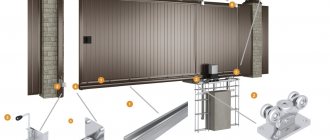OPERATING PRINCIPLE LABORATORY POWER
An autotransformer (AT) is a type of transformer that is characterized by the presence of only one winding on the magnetic core, which has several taps.
Each tap corresponds to a certain voltage level. Thus, when they talk about the primary or secondary winding of an autotransformer, they mean one or another winding tap.
The peculiarity of the electrical circuit of an autotransformer, which consists in the presence of only one winding, determines the difference between its technical parameters and the characteristics of a conventional transformer.
The main differences can be stated as follows:
- higher efficiency compared to a conventional transformer;
- lower consumption of copper and steel in the manufacture of winding conductors and magnetic cores, correspondingly lower weight and cost of equipment for the same power;
- the presence of a galvanic connection between primary and secondary electrical networks.
The increased efficiency of the device is determined by the fact that not all of the transformed power undergoes electromagnetic conversion, since the primary and secondary windings have a common area. As a result, the energy losses in the copper and steel of the autotransformer are lower than those of a transformer of similar power.
Eliminating the need to manufacture and install a second winding coil with a conductor significantly reduces the weight of the device and creates better conditions for cooling copper and steel.
The galvanic connection between the primary and secondary electrical networks is considered to be a disadvantage of the device, however, in networks with a grounded neutral, this feature does not play a role, and the gain in the price of equipment and the reduction of losses can be very significant.
Operating principle
The basic principle of operation of an autotransformer is similar to a conventional device:
- the current flowing through the primary winding creates a magnetic field and magnetic flux in the magnetic circuit;
- the magnitude of this field depends on the current strength and the number of turns;
- changes in magnetic flux induce an emf in the secondary winding;
- the magnitude of the induced EMF depends on the number of turns in the secondary winding.
The peculiarity of the autotransformer is that part of the turns of the primary winding is also secondary. Due to the fact that the EMF in the primary and secondary windings are directed in opposite directions, the current in the common part of the coil I¹² is equal to the difference between I¹ and I². If the input and output voltages are equal or Ktr=1 I¹² is determined by the inductive reactance of the coil.
Autotransformer
Autotransformers
are one of the types of voltage transformers, the distinctive design feature of which is that they have only one winding.
The minimum number of autotransformer outputs is three; with a larger number, it is possible to obtain different voltage values at the output.
From the above diagrams it is clear that the windings are electrically connected: the lower voltage winding is part of the higher voltage winding.
Operating principle of an autotransformer
.
When voltage passes from an alternating current source connected to a winding with the full number of turns W1
, an emf induced by a magnetic flux occurs.
Its value depends in direct proportion on the number of turns of the winding W2 involved, to which the load R
(see diagram 1).
Having designated the conditionally induced in the winding with the number of turns W1
the magnitude of the EMF
E1
, and in the winding with
W2 - E2
k
can be mathematically expressed by the following relationship:
E1/E2=W1/W2
.
Due to the insignificance of the voltage drop in the winding due to the relatively low resistance, we take U1 = E1
and
U2=E2
.
Thus, the ratio E1/E2=W1/W2
can be reduced to the form
U1/U2=W1/W2
, from which it is clear that the secondary voltage will be less than the primary voltage
(k)
by the same amount as the number of turns of the
W2
winding
less than W1
.
In the example under consideration, a step-down transformer is used (W1>W2)
, with the number of turns
W1
less than
W2
(see diagram 2), the secondary voltage will be greater than the primary based on the same ratio
U1/U2=W1/W2
.
Scope of application of autotransformers
is quite wide: low-power devices are used for powering, setting up and testing household and industrial electrical equipment, automatic control devices, in laboratory stands - LATRs, communication devices, etc. Power three-phase autotransformers can be used to reduce the starting voltages of powerful electric motors.
In the energy sector, high-power autotransformers are successfully used to connect high-voltage networks with similar voltages (110-220 kV, 220-500 kV, 330-750 kV). The transformation coefficient of these devices, as a rule, does not exceed 2-2.5. For voltage changes greater than these values, the economic feasibility of using autotransformers is significantly reduced.
For these purposes, three-phase autotransformers are used, with star (the most commonly used circuit) or delta winding connections.
Main pros and cons
Due to its design features, the autotransformer has advantages and disadvantages compared to conventional devices.
Advantages of an autotransformer, manifested at Ktr0.5-2:
- less weight and dimensions;
- higher efficiency associated with reduced losses in the windings and magnetic core.
In addition to advantages, these devices have disadvantages:
- Increased short-circuit current. This is due to the fact that the load current is limited not by the saturation of the magnetic circuit, but by the resistance of several turns of the secondary winding.
- Electrical connection between the primary and secondary windings. This makes it impossible to use these devices as separation devices and for powering low-voltage devices in hazardous conditions that require low voltage according to the Electrical Regulations.
Autotransformer power
The power of any electrical device is equal to the product of current and voltage P=I*A. In a conventional transformer, it is equal to the load power, taking into account the efficiency.
The power of an autotransformer is calculated a little differently. In a voltage-increasing device, it consists of the power of the primary winding of the part P¹²=I¹²*U¹² and the power of the step-up winding P²=I²*U⅔. Due to the fact that the current flowing through the primary coil is less than the load current, the power of the autotransformer is less than the load power. In fact, the power of the device is determined by the difference between the primary and secondary voltages and the secondary winding current P=(U¹-U²)*I².
This is especially noticeable with small (10-20%) deviations in the output voltage. The step-down autotransformer is calculated in a similar way.
Information! This makes it possible to reduce the cross-section of the magnetic core and the diameter of the winding wire. In this regard, the autotransformer is lighter and cheaper than a conventional device.
OPERATING PRINCIPLE OF AUTOTRANSFORMER
Let's consider the principle of operation of the device using the example of the simplest circuit with a winding coil having three taps - two extreme and one middle (Fig. 1).
The full number of turns of the winding Wв is connected to the high voltage network, part of the turns before the tap Wн is connected to the low voltage side. The bottom pin in the diagram is common.
In the case when the device is used as a boost converter, the supply voltage is supplied to the terminals Un, and its increased value is removed from the terminals U as a result of transformation. If the power is directed from Uв to Un, the supply voltage is connected to the high-side taps.
The transformation ratio is a scale indicator of device transformation and in this case is determined in the same way as for a conventional transformer:
K = Uв/Un = Wв/Wн,
that is, it is numerically equal to the ratio of the number of turns of the primary and secondary windings. The transformation ratio can also be expressed in terms of current values. The relationship in this case will be the opposite:
K = Iн/Iв = Wв/Wн,
which illustrates that with an increase in the number of turns and, accordingly, the value of U of the winding, the current in it decreases proportionally. Physically, this means that the power values in the windings are the same if the magnitude of losses is neglected.
The scope of application of autotransformers extends to various industries, including:
- energy (power supply), where these high-power devices are widely used at network electrical substations;
- electronics, in which many radio devices contain AT;
- laboratory electrical devices for regulating electrical parameters (LATR).
Rice. 1. Autotransformer windings: 1—three-phase; 2—single-phase
The distribution of currents in an operating autotransformer in rated load mode between the windings is not the same. The series winding AmA carries the load current HV - IA. According to the law of electromagnetic induction, a magnetic flux is created in the autotransformer core, which induces a current IAm in the MV winding. Thus, the current of the common winding CH is formed by the sum of the currents of the series winding IA with electrical connection (HV and CH), and the current IAm, along the magnetic connection of the same windings - ICH = IA + IAm .
Rice. 1. Autotransformer windings: 1—three-phase; 2—single-phase
The power value at the output of the autotransformer is equal to the power at its input. In the absence of a LV winding, the HV power is equal to the MV power, this is the rated power Snom of the autotransformer via electrical communication. It is equal to the product of the rated voltage of the HV winding UВН and the rated current IВН of the series winding.
The typical power of the autotransformer is also calculated, which is part of the rated power transmitted electromagnetically.
St=Snom*av , where av=1-UСН/UВН is the profitability coefficient of the autotransformer. It determines the share of typical power in the rated power; the smaller it is, the smaller the dimensions and cross-sections of the core (magnetic core) and windings of the autotransformer, which are calculated based not on the full rated power, but only on its part - the typical power. Therefore, the manufacture of autotransformers is much cheaper than conventional transformers of the same power.
The power on the common winding is one of the main parameters that need to be controlled when operating an autotransformer; exceeding it in long-term mode is unacceptable. Figure 1 shows options for connecting an ammeter to measure the load on a common winding with a three-phase and single-phase version of the autotransformer.
The lower the transformation ratio (the closer the values of UСН and UВН), the more profitable the use of autotransformers and the cheaper their manufacture.
Figure 2 shows circuits for regulating the voltage of the Am output on the autotransformer on the HV side (1) and on the MV side (2). These are the design and operating principles of autotransformers.
2. Less weight and dimensions make it possible to create high-power transformers.
The power transmitted by the primary winding to the secondary circuit of the autotransformer will be equal to:
Considering that I2 = I1 + I12, it can be written as:
Here U2 I1 = SE is the power supplied to the secondary circuit electrically, U2 I12 = Sм is the power supplied to the secondary circuit through magnetic flux.
Consequently, in an autotransformer only part of the power is transmitted through magnetic flux, which makes it possible to reduce the cross-section of the magnetic circuit. Magnetic losses are also reduced. With a smaller cross-section of the magnetic circuit, the average length of the winding turn decreases, therefore, the consumption of winding copper again decreases and electrical losses are reduced.
1. Less consumption of copper, steel, as well as insulating materials and lower cost compared to transformers of the same power.
2. Less weight and dimensions make it possible to create high-power transformers.
3. Autotransformers have lower losses and higher efficiency.
4. Have better cooling conditions.
1. The need for solid grounding of the neutral, which leads to an increase in single-phase short-circuit currents.
2. Difficulty in voltage regulation.
3. The danger of atmospheric overvoltage transfer from one winding to another due to the electrical connection of the windings.
A single-phase autotransformer has only one winding. In idle mode, the autotransformer is no different from a conventional transformer. In load mode, a current flows through the common part of the turns, which is equal to the current difference ( i 1
- i 2 ),
since the secondary current weakens the magnetic flux in the core (i.e., the corresponding magnetic flux has a sign opposite to the sign of the flux created by the primary winding current ).
What is LATR
In addition to power devices that replace conventional transformers, schools, institutes and laboratories use LATRs - Laboratory Autotransformers. These devices are used to smoothly change the voltage at the output of the device. The most common designs are a coil wound on a toroidal magnetic circuit. On one side the wire is cleared of varnish and a graphite roller moves along it using a rotating mechanism.
The supply voltage is supplied to the ends of the coil, and the secondary voltage is removed from one of the ends and the graphite roller. Therefore, LATR cannot raise the voltage above the mains voltage, in some modifications above 250V.
In addition to reel-to-reel ones, there are electronic LATRs. In fact, this is not an autotransformer, but a voltage regulator. There are different types of such devices:
- Thyristor regulator. In these devices, a thyristor and a diode bridge or triac are installed as a power element. The disadvantage is the absence of a sinusoidal output voltage. The most famous device of this type is a lighting lamp dimmer.
- Transistor regulator. More expensive than thyristor, requires installation of transistors on radiators. Provides a sinusoidal output voltage.
- PWM controller.
Advice! In order to obtain a voltage higher than the mains voltage, LATR is connected to the secondary winding of the step-up transformer.
What is an autotransformer?
With the development of energy and related electrical networks for transmitting alternating current as a power source for various devices, the need arose for devices that change the voltage value. Transformers have become such universal electromagnetic devices that allow increasing or decreasing the initial voltage to the required value.
Over time, to ensure stable operation of electrical appliances, mainly for household purposes, the need arose for smooth voltage regulation. This became possible after the invention of the autotransformer - a device in which the secondary winding is an integral part of the primary turns.
What is an autotransformer?
From a school physics course we know that the simplest transformer consists of two coils wound on iron cores. The magnetic field of alternating current, powered through the terminals of the primary windings, excites electromagnetic oscillations in the second coil, with a similar frequency.
When a load is connected to the terminals of the working winding, it forms a secondary circuit in which an electric current arises. In this case, the voltage in the formed electrical circuit is directly proportional to the number of turns of the windings. That is: U1/U2 = w1/w2, where U1, U2 are voltages, and w1, w2 are the number of full turns in the corresponding coils.
Figure 1. Diagram of a conventional transformer and autotransformer
The autotransformer is designed a little differently. It essentially consists of one winding, from which one or more taps are made, forming secondary turns. In this case, all windings form not only an electrical, but also a magnetic connection with each other. Therefore, when electrical energy is supplied to the input of the autotransformer, a magnetic flux arises, under the influence of which an emf is induced in the load winding. The magnitude of the electromotive force is directly proportional to the number of turns forming the load winding from which the voltage is removed.
Thus, the formula given above is also valid for an autotransformer.
A large number of leads can be drawn from the main winding, which allows you to create combinations for removing voltages of different magnitudes. This is very convenient in practice, since voltage reduction is often required to power several units of electrical appliances using different voltages.
The difference between an autotransformer and a conventional transformer
As can be seen from the description of the autotransformer, its main difference from a conventional transformer is the absence of a second coil with a core. The role of secondary windings is performed by separate groups of turns having a galvanic connection. These groups do not require separate electrical insulation.
Application area
The features of the autotransformer allow it to be used in everyday life and various areas of industry.
Metallurgical production
Regulated autotransformers in metallurgy are used to check and adjust the protective equipment of rolling mills and transformer substations.
Utilities
Before the advent of automatic stabilizers, these devices were used to ensure the normal operation of televisions and other equipment. They consisted of a winding with a large number of taps and a switch. He switched the output of the coil, and the output voltage was controlled using a voltmeter.
Currently, autotransformers are used in relay voltage stabilizers.
Reference! In three-phase stabilizers, three single-phase autotransformers are installed, and adjustment is made in each phase separately.
Chemical and petroleum industry
In the chemical and petroleum industries, these devices are used to stabilize and regulate chemical reactions.
Production of equipment
In mechanical engineering, such devices are used to start electric motors of machine tools and control the rotation speed of additional drives.
Educational establishments
In schools, technical schools and institutes, LATRs are used to perform laboratory work and demonstrate the laws of electrical engineering, and experiments on electrolysis.
Making a homemade LATR
There are quite a few ready-made devices on the market, but if necessary, you can make one yourself. It is better to take a transformer on an O- or W-shaped magnetic circuit as a basis. Making a LATR on toroidal iron comes down to rewinding it and requires very high care when winding the coil.
Preparation of material
To make an adjustable autotransformer you need:
- Magnetic core. Its cross section determines the power of the autotransformer.
- Winding wire. Its cross section depends on the power and current consumption of the device.
- Heat-resistant varnish. Necessary for impregnation of the coil after winding the wires. Replacement with oil paint is allowed.
- Cloth insulating tape or keeper tape and a housing with fixed connectors for connecting the load and power. It is advisable to place a digital or analog voltmeter in the housing
- Multi-position switch. Its permissible current must correspond to the current of the device. If necessary, it is possible to switch the autotransformer terminals using starters.
Wire calculation
Before you start winding the coil, you need to determine the cross-section of the wire and the required number of turns/volts (n/v). This calculation is made based on the cross section of the magnetic core using online calculators or special tables.
If a working transformer is used to manufacture the device, then these parameters are determined from the available windings:
- connect the transformer to a 220V network;
- use a voltmeter to measure the output voltage V;
- turn off the device;
- disassemble the magnetic circuit;
- unwind the secondary winding, counting the number of turns N;
- using the formula n/v=N/V, calculate the number of turns/volts - the main parameter for calculating the coil;
- measure the cross-section of the primary winding wire.
Advice! If the primary winding has not been impregnated with varnish and is unwound without breaking the insulation, then it can be used to wind an autotransformer coil.
Scheme
Before starting work, a winding diagram is drawn up indicating the number of turns and the voltage at each terminal. Unlike a conventional transformer, an autotransformer has only one winding, which is depicted on one side of the line symbolizing the magnetic circuit.
To calculate turns, it is necessary to determine the number of pins. It depends on the number of positions of the multi-position switch. One of the taps may coincide with the network pin:
- determine and indicate on the diagram the voltage V of each of the switch positions;
- calculate the required number of turns between taps using the formula N=(n/v)*(V²-V³), where V¹, V², V³, etc. – voltage at subsequent terminals;
- indicate on the diagram the number of turns between each of the taps.
Advice! If it is necessary to make a step-up autotransformer, the required number of turns is added to the primary winding. To do this, it is allowed to use a wire removed from the secondary winding.
Coil winding
After all calculations have been completed, the coil is wound. It is performed on a finished or specially made frame manually or using a winding machine:
- the required number of turns in the section is wound;
- a branch is made - from the winding wire, without breaking it, a loop 5-20 cm long is made and twisted into a bundle;
- after making the tap, winding of the coil continues;
- operations 1-3 are repeated until winding is completed;
- the finished winding is secured with keeper tape and covered with varnish or paint.
Build process
After winding is completed and the varnish has dried, the autotransformer is assembled:
- the magnetic circuit is assembled;
- the assembled device is installed in the housing;
- a multi-position switch and a voltmeter are connected;
- the assembled autotransformer is connected to the terminals.
Examination
After assembly, the functionality of the device must be checked:
- the primary winding of the device is connected to the network;
- Voltages are measured at each switch position and the data are compared with the calculated ones;
- after 20 minutes, the transformer is turned off and checked for heating - if there is no heating, repeated tests are carried out under load.
Electronic autotransformer
A more modern way of adjustment is the use of electronic devices. Any of them can be made with your own hands.
Thyristor regulator
The simplest circuit of such a device is a variable resistor connected between the anode and the control electrode of the thyristor. This allows you to receive a pulsating DC voltage and control it in the range of 0-110V.
To regulate the alternating voltage 0-220V, an anti-parallel connection circuit is used, and a resistor is connected between the control electrodes.
Instead of two thyristors, it is advisable to use a triac, and use a dimmer for incandescent lamps as a control circuit.
Transistor control
The highest quality adjustment is obtained when using a transistor regulator. It provides a smooth change and correct shape of the output voltage.
The disadvantage of this circuit is that the output transistors heat up. To reduce it and increase efficiency, it is advisable to connect the regulator to the output terminals of the autotransformer - rough adjustment is carried out by switching windings, and smooth adjustment is carried out using transistors.
Design and principle of operation of the transformer
Home > Test >Physics
Design and principle of operation of the transformer
A transformer is a static electromagnetic device that serves to convert alternating current of one voltage and alternating current of the same frequency, but of a different voltage. The need for transformation—increasing and decreasing alternating voltage—is caused by the need to transmit electrical energy over long distances. The higher the voltage, the lower the current for equal power of the energy source. Consequently, energy transmission requires wires of a smaller cross-section, which leads to significant savings in non-ferrous metals from which power line wires are made. Electrical energy losses in wires also decrease with decreasing current. When transmitting electrical energy from power plants to consumers, voltage increases and decreases multiple times.











